Past, present, future: Jennifer Egan on writing
November 10, 2017
Eight years ago, Jennifer Egan found herself at a reunion for deep-sea diving army veterans, trying on a 200-pound Mark V diving suit. Research, the Pulitzer-prize winning author told a packed crowd in Kresge Auditorium last night, for her latest and fifth novel, “Manhattan Beach.”
Before signing books, Egan read the first chapter of the novel and answered questions about her research and writing process.
Following a young female diver working in the Brooklyn Naval Yard during World War II, “Manhattan Beach,” longlisted for the 2017 National Book Award, is “an old-fashioned adventure story that … combines urban noir with a maritime sea survival story,” according to Egan.
Like her other novels, “Manhattan Beach” plays with time; however, instead of the futuristic leaps that define her Pulitzer-prize winning 2010 novel “A Visit from the Goon Squad,” “Manhattan Beach” structurally lodges itself in the past. And yet, as much as Egan noses into the minds of organized crime bosses and Irish-American waterfront workers of the 1930s and 40s, the novel remains much more than strictly historical fiction.
“The reader and I understand that this is a story set in the past but written in the present,” Egan said. “I don’t have to remind [the reader] that I’m in the present writing this, so in a way all of the history that follows … is like a layer hanging there almost allegorically in both of our minds.”
 Sam Honegger
Sam HoneggerWith curiosity and investigative skills cultivated from her journalism experience, Egan plunged into several years of research—studying fiction from the time period, interviewing people and visiting site locations. Fourteen hundred handwritten legal pad pages later Egan had her first draft.
“Up until a certain point of knowing a great deal [of history] … I felt like I was not fluent in a language and therefore my writing personality was simply not coming through,” said Egan. “I did not have the fluency to do what I like to do, which is get deeply inside people’s minds … to have a kind of understanding of [people’s] habits of mind, the way people organize the world, which is really different for all of us.”
“It’s not just enough to know what people did in that moment,” Egan continued. “I felt that I needed to know what their memories contained, both singularly and collectively.”
So engrossed in her research, Egan even worked with the Brooklyn Naval Yard and the Brooklyn Historical Society to create an oral history of the waterfront with interviews from veteran workers, many of whom were women.
“I usually have an atmosphere [that] I start with,” Egan said of her writing process. “I’ll have some notions of what kinds of ideas I might be exploring. I wanted to write a book specifically about being a woman—I had been thinking about that for a while.”
“For a while” meant seven years. During the time Egan submersed herself in research about the waterfront, she wrote her 2006 novel “The Keep” as well as “A Visit from the Goon Squad” four years later. In 2012, Egan began writing “Manhattan Beach.”
At first, Egan considered “A Visit from the Goon Squad” a distraction from her research, born from a series of letters she stumbled upon written by a woman named Lucille to her seafaring husband, Al, who was in the Navy during World War II.
“‘Ah, Butch, I wonder what our lives will be like. Will we have children? Will we live in California? Will we stay in New York and Brooklyn?’” Egan said during the event, quoting from one of Lucille’s letters.
Curious about Lucille’s fate and even hoping for an interview, Egan searched Lucille’s name in the computer and was immediately confronted by her obituary.
“And that was that. I felt stricken. It seemed like I shouldn’t know [what her life would be] so [quickly] after reading her handwriting,” Egan said. “I already knew the end of the story … It made me think about how differently the present reads if you know the end of the story.”
Channeling this feeling into her fiction, Egan crafted a complex novel, “A Visit from the Goon Squad,” that flips between characters, time period and style, the present of each chapter overlaid with a sense of the future. True to her reputation of experimenting with form and technology—she once wrote a short story as a series of tweets published on the New Yorker’s Twitter account—one chapter of “A Visit From the Goon Squad” was even in PowerPoint format.
“I always love it if I can mix up things that don’t seem like they can go together,” Egan said. From PowerPoint presentations to female deep-sea divers, Egan does just that.

Comments
Before submitting a comment, please review our comment policy. Some key points from the policy: